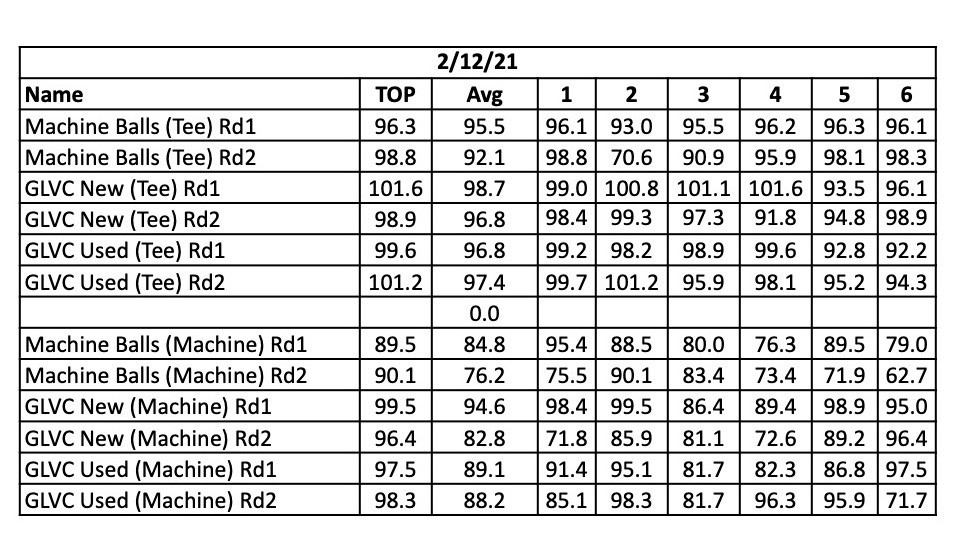As I discussed last week in the article about the modern baseball, I was able to conduct an experiment last Friday at the University of Indianapolis. Let me be very up front — this is not a perfect experiment in a lot of ways, but I think we can learn something from the “quick and dirty” look. Let me walk you through what we did.
First, we selected one dozen balls of each type. Batch “A” is a dozen NCAA standard balls manufactured by Rawlings. These are not identical to the MLB ball, but they were easily accessible. They are each stamped “China EOSB4”, which is the same ‘BLACKHORSE’ code that is printed inside the MLB balls. Dr. Meredith Wills confirmed that this code means they were manufactured in late July of 2019. These balls were purchased in late 2019 ahead of the 2020 season, which didn’t get deep enough for UIndy to use these balls. The box was not sealed, but the balls were still in their individual wrapper. They were all marked as “GLVC” for the Great Lakes Valley Conference and are noted as such on our results.
The second dozen balls — Batch “B” — was selected from game used balls of the same type and noted as “GLVC Used.” Each could be identified by either the conference stamp or the Rawlings stamp, though these balls have been heavily used, first in a game and then second as balls used in batting practice, drills, and other baseball activities. We took several buckets of these balls, selected several, and then conducted a drop test to get as many near-identical balls as possible. These were not tested for size, sphericity, or measured digitally, simply for the lack of equipment. The balls were still in good, usable condition, but were notably “softer” to the touch.
The final dozen balls — Batch “C” — was selected in much the same way as “B”, but were taken from special pitching machine balls. These balls are the same size and weight, but are designed for durability with seams that are flatter and made of kevlar. These balls have been in use through the fall and into the spring, but were drop tested and felt slightly “harder” to the touch.
We then took all three batches into the cage. We used one batter on the tee, doing rounds of six, using the same bat (a Rawlings 33/30), then used another batter off the machine, using a DeMarini 33/30. Each batter has regularly had his exit velocity measured as part of the team’s training and both regularly generate around 100 mph off the bat. The pitching machine was set to throw fastballs at 85mph, though there was slight variation. Each of these hits was measured by the HitTrax system. A spot test of a few hits by a Stalker gun showed that the HitTrax system was slightly higher than the Stalker’s speed, but the results appear internally consistent.
Those results are … not clear. There’s very little consistency and the expected hardness of the “machine balls” - Batch “C” - did not match results. There’s a couple mishits in there, which is to be expected, even off a tee. The variations are reasonable when you consider factors like fatigue, swing plane, launch angle, and others. A five mile per hour variation in average is barely worth mentioning and when you notice that heavily used balls can be as hard hit as ones fresh out of the wrapper, I begin to think that a demonstrably softer ball may not be the answer to the issue.
Even within a single box of balls, there’s likely distinct variation, but this is the same company that will be supplying hundreds of thousands of balls to MLB and saying that they can consistently produce a ball that is five percent “deader.” I don’t believe it.
Even if a ball could be consistently produced, the results it gives in game are so confounding that it’s nearly irrelevant. When you add in the element of the pitcher and the inconsistent delivery of pitches, being able to connect and generate maximum exit velocity on the ball is paramount and a softer ball will have variation, but it is as likely to be so variable as to be almost unpredictable.
This study was quick and dirty. There were many steps we could have taken to further control variation, including a much larger sample size, and certainly more controlled experiments would need to be done to generate actionable conclusions. What I was trying to do was test whether or not it’s plausible that a demonstrably “deader” ball would create significant drops in exit velocity. For that, this experiment was a success. We saw that a deader ball does not consistently reduce exit velocity.
I’d love for those out there that are smarter than me to make suggestions about how this could be done and I’d invite any of you out there to try to do a better, more controlled experiment that what I’ve done here.
Here’s videos that show some of what we did. There’s no sound because there was music playing in the cages, so I got hit with a “copyright violation” when I first uploaded them!
The Drop Test
Hitting off Tee
What HitTrax Shows
Hitting off Machine






Will you be doing any injury previews or updates for the upcoming season? Guys you would stay away from or if any of the injury metrics out there you believe in?